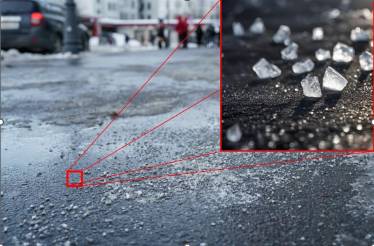The Great Salt Debate
Hazardous roads during the winter are a genuine concern in Kansas City. The Kansas Department of Transportation used 82,000 tons of road salt in the winter of 2023-2024, and the Missouri Department of Transportation used around 118,196 tons. The U.S. uses approximately 25 million tons of salt to deice the roads. For reference, the entire country of Canada uses around 5 million tons of salt per year. These numbers are concerning when considering where all that salt ends up, in our water. 
Another factor in the equation is that the numbers listed above are only the public works and municipal numbers. Private applications made by homeowners and landscape companies on sidewalks and driveways are not included.
Our small streams and waterways are most affected by the widescale use of salts. Water that travels along urban and developed areas can measure up to 20-10 times higher than the EPA’s threshold on the salinity of waterways, which is 230 milligrams per liter. Not only does this have negative effects on the surface water, but ground water and private wells also can be affected. Salting on sidewalks and driveways can also run off into your lawn and landscape, poisoning your plants.
There are very few ecologically friendly options to effectively clear the roads of ice. However, we can adopt best practices to mitigate our salt use. One strategy that has been used effectively is mixing the salt in water to make a brine. This solution is then sprayed on the roads as a pretreatment for icy roads. Salt spread on the road must react with water to lower the freezing temperature. This is a timely process, especially when dealing with rock salt. By mixing salt into a brine, the salt is already dissolved in the solution, making the effects immediate. Studies show that using a brine mixture has the potential to reduce salt consumption by 20%. Brine mixtures can include different types of salt depending on the conditions present. The Kansas Department of Transportation has even used some organic additives, such as beet juice, into the brine, prolonging its effectiveness.
There are some drawbacks to consider when using brine. If it is actively snowing, the added water from the snow can dilute the solution and raise the freezing point back up. In this scenario, another application of brine would be needed.
Temperature can also play a role in the performance of the brine. Sodium chloride brine has a limit to how much salt can be concentrated in a solution before it can no longer melt ice. The max salt concentration in solution is 23.3 % (2.54 lbs. of salt per gallon); beyond this concentration, salt crystallization will occur where the salt drops out of the solution and washes off the road. Below 20°F, additives, and other chlorides are needed to keep freezing from happening. Typically, sodium chloride and other additives can be used until the pavement reaches -6°F.
Using brine is very important in places that receive much more snow than our area. In states in the north, companies, businesses, homeowners, and public works employees can take a class to become certified in brine calibration and application. With this certification, they are granted limited liability insurance. One study from the University of Connecticut showed that after the university’s facilities staff took the training over a two-year period, the university saved $459,251 by applying 3,479 fewer tons of salt. These results have been duplicated in many other states and municipalities nationwide.
by Markis Hill, Horticulture Turf and Ornamentals Agent, 2024
Return to Horticulture Agent Articles